University Healthcare Report: Wearable Technologies Literature Review
VerifiedAdded on 2021/04/19
|11
|2434
|39
Report
AI Summary
This report presents a comprehensive literature review on the application of wearable technologies in healthcare. It explores the evolution of wearable devices, their ability to monitor various health metrics, and their impact on patient care. The review examines the use of wearable technologies in surgical practices, respiratory disease management, and the treatment of osteoarthritis. It discusses the different types of wearable devices, including those used for assessment, augmentation, and assistance, and highlights their benefits in terms of real-time data collection, improved patient monitoring, and enhanced patient-clinician communication. The report also addresses the challenges associated with wearable technologies, such as data security, sensor accuracy, and the high cost of devices. Additionally, it explores the potential of these technologies to reduce healthcare costs, improve patient comfort, and increase the efficiency of healthcare services. The report concludes with a summary of the key findings and suggests areas for further research, such as comparing the performance of wearable technologies with conventional monitoring systems and improving the effectiveness of these technologies. This report is a valuable resource for understanding the current state and future potential of wearable technologies in healthcare.
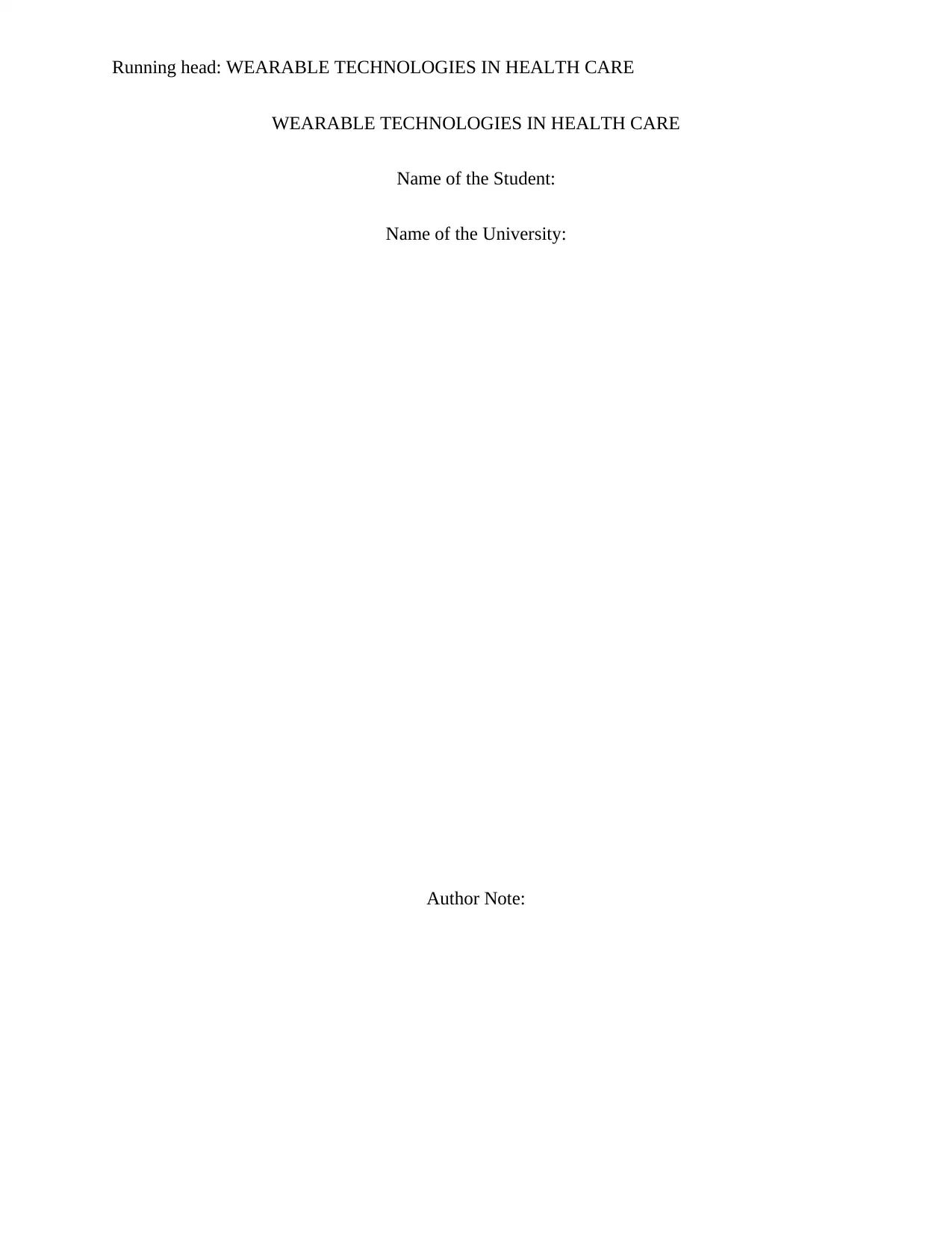
Running head: WEARABLE TECHNOLOGIES IN HEALTH CARE
WEARABLE TECHNOLOGIES IN HEALTH CARE
Name of the Student:
Name of the University:
Author Note:
WEARABLE TECHNOLOGIES IN HEALTH CARE
Name of the Student:
Name of the University:
Author Note:
Paraphrase This Document
Need a fresh take? Get an instant paraphrase of this document with our AI Paraphraser
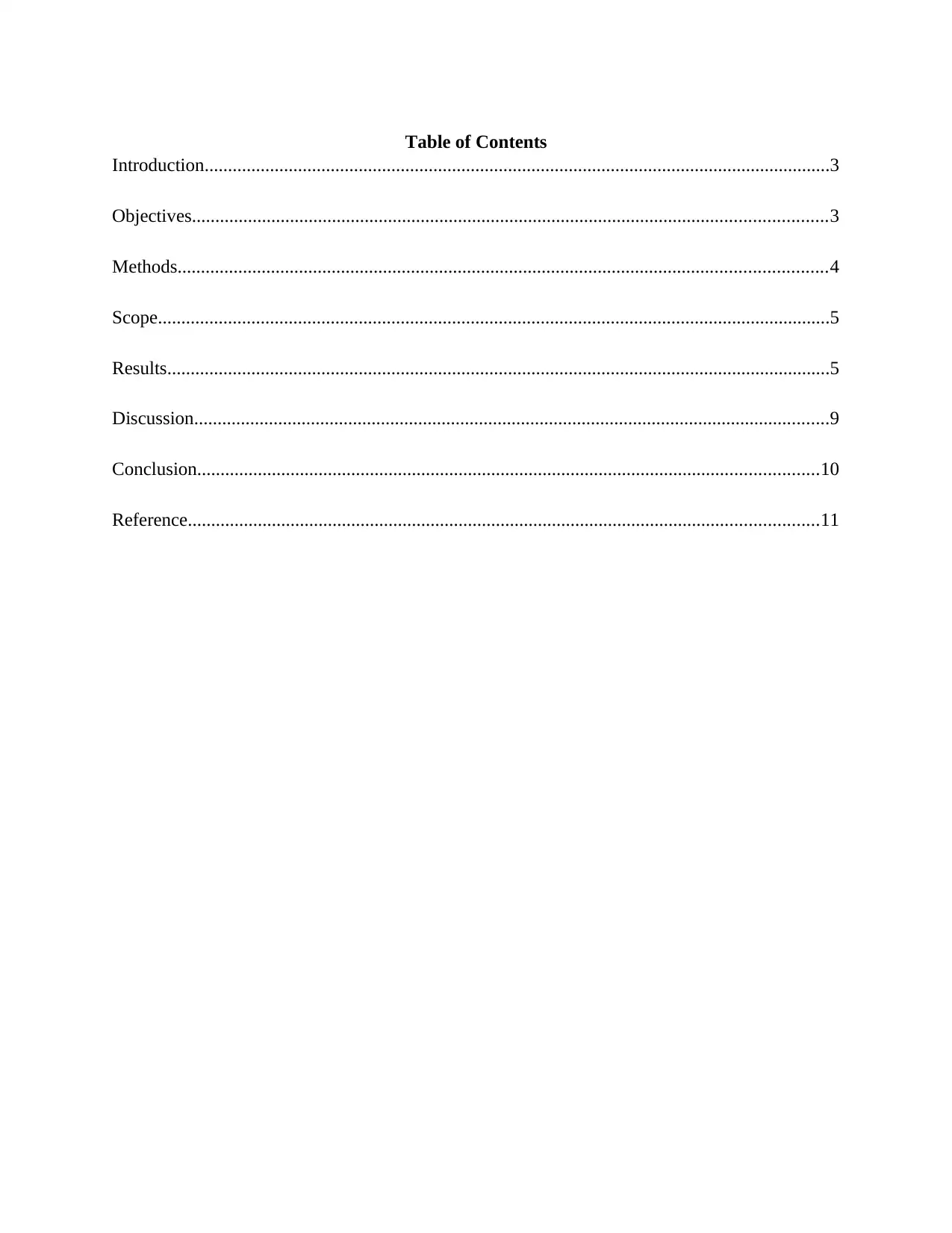
Table of Contents
Introduction......................................................................................................................................3
Objectives........................................................................................................................................3
Methods...........................................................................................................................................4
Scope................................................................................................................................................5
Results..............................................................................................................................................5
Discussion........................................................................................................................................9
Conclusion.....................................................................................................................................10
Reference.......................................................................................................................................11
Introduction......................................................................................................................................3
Objectives........................................................................................................................................3
Methods...........................................................................................................................................4
Scope................................................................................................................................................5
Results..............................................................................................................................................5
Discussion........................................................................................................................................9
Conclusion.....................................................................................................................................10
Reference.......................................................................................................................................11
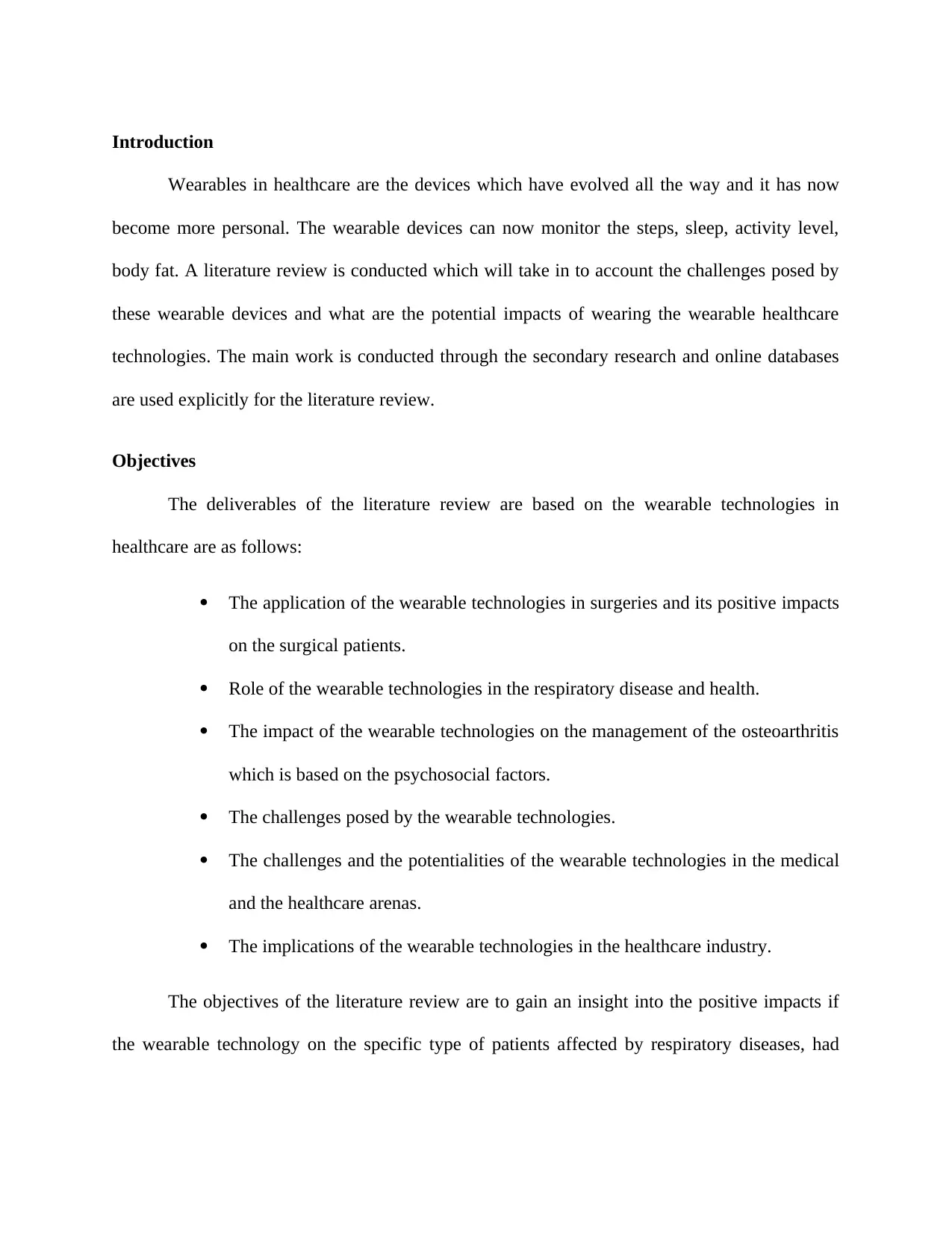
Introduction
Wearables in healthcare are the devices which have evolved all the way and it has now
become more personal. The wearable devices can now monitor the steps, sleep, activity level,
body fat. A literature review is conducted which will take in to account the challenges posed by
these wearable devices and what are the potential impacts of wearing the wearable healthcare
technologies. The main work is conducted through the secondary research and online databases
are used explicitly for the literature review.
Objectives
The deliverables of the literature review are based on the wearable technologies in
healthcare are as follows:
The application of the wearable technologies in surgeries and its positive impacts
on the surgical patients.
Role of the wearable technologies in the respiratory disease and health.
The impact of the wearable technologies on the management of the osteoarthritis
which is based on the psychosocial factors.
The challenges posed by the wearable technologies.
The challenges and the potentialities of the wearable technologies in the medical
and the healthcare arenas.
The implications of the wearable technologies in the healthcare industry.
The objectives of the literature review are to gain an insight into the positive impacts if
the wearable technology on the specific type of patients affected by respiratory diseases, had
Wearables in healthcare are the devices which have evolved all the way and it has now
become more personal. The wearable devices can now monitor the steps, sleep, activity level,
body fat. A literature review is conducted which will take in to account the challenges posed by
these wearable devices and what are the potential impacts of wearing the wearable healthcare
technologies. The main work is conducted through the secondary research and online databases
are used explicitly for the literature review.
Objectives
The deliverables of the literature review are based on the wearable technologies in
healthcare are as follows:
The application of the wearable technologies in surgeries and its positive impacts
on the surgical patients.
Role of the wearable technologies in the respiratory disease and health.
The impact of the wearable technologies on the management of the osteoarthritis
which is based on the psychosocial factors.
The challenges posed by the wearable technologies.
The challenges and the potentialities of the wearable technologies in the medical
and the healthcare arenas.
The implications of the wearable technologies in the healthcare industry.
The objectives of the literature review are to gain an insight into the positive impacts if
the wearable technology on the specific type of patients affected by respiratory diseases, had
⊘ This is a preview!⊘
Do you want full access?
Subscribe today to unlock all pages.

Trusted by 1+ million students worldwide
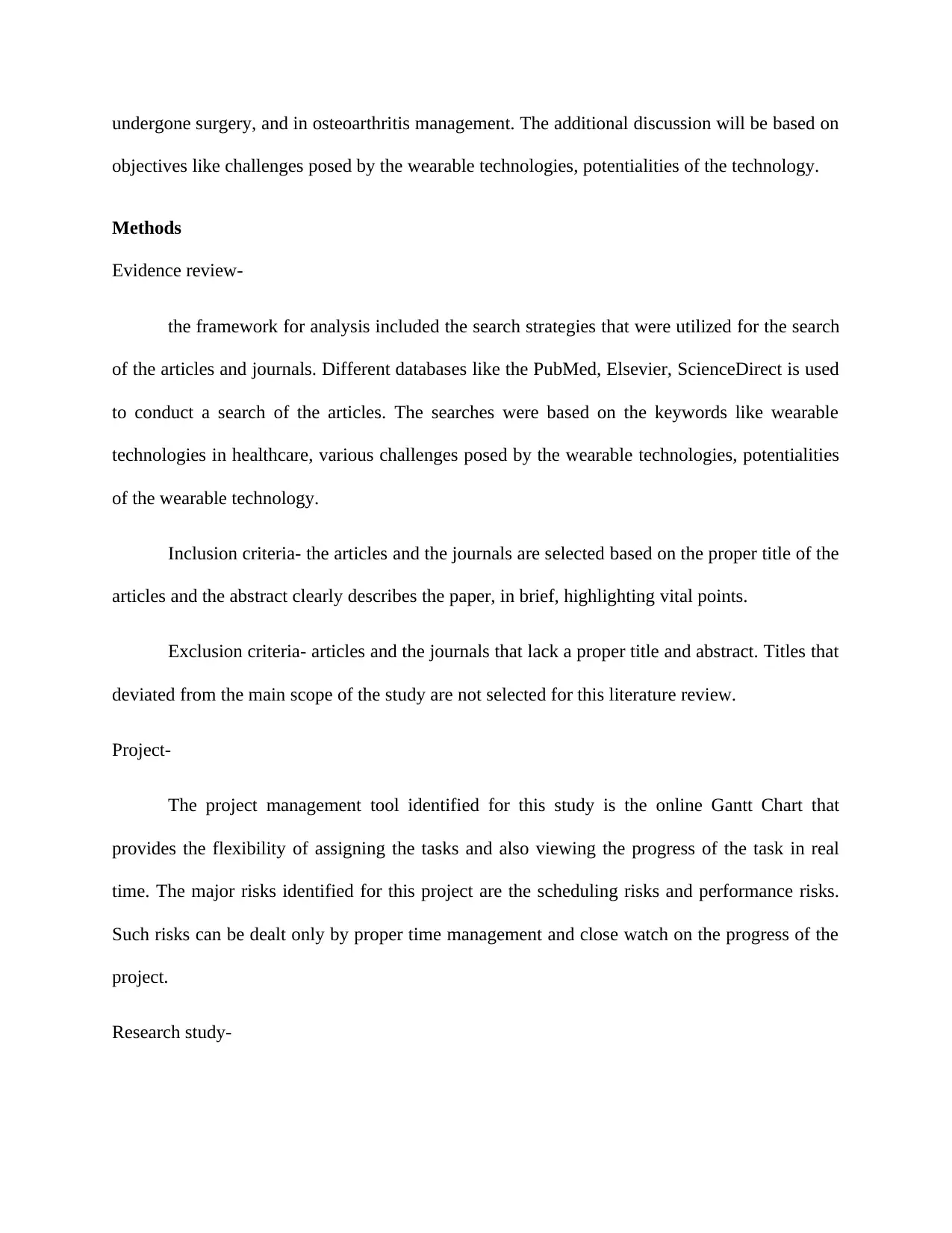
undergone surgery, and in osteoarthritis management. The additional discussion will be based on
objectives like challenges posed by the wearable technologies, potentialities of the technology.
Methods
Evidence review-
the framework for analysis included the search strategies that were utilized for the search
of the articles and journals. Different databases like the PubMed, Elsevier, ScienceDirect is used
to conduct a search of the articles. The searches were based on the keywords like wearable
technologies in healthcare, various challenges posed by the wearable technologies, potentialities
of the wearable technology.
Inclusion criteria- the articles and the journals are selected based on the proper title of the
articles and the abstract clearly describes the paper, in brief, highlighting vital points.
Exclusion criteria- articles and the journals that lack a proper title and abstract. Titles that
deviated from the main scope of the study are not selected for this literature review.
Project-
The project management tool identified for this study is the online Gantt Chart that
provides the flexibility of assigning the tasks and also viewing the progress of the task in real
time. The major risks identified for this project are the scheduling risks and performance risks.
Such risks can be dealt only by proper time management and close watch on the progress of the
project.
Research study-
objectives like challenges posed by the wearable technologies, potentialities of the technology.
Methods
Evidence review-
the framework for analysis included the search strategies that were utilized for the search
of the articles and journals. Different databases like the PubMed, Elsevier, ScienceDirect is used
to conduct a search of the articles. The searches were based on the keywords like wearable
technologies in healthcare, various challenges posed by the wearable technologies, potentialities
of the wearable technology.
Inclusion criteria- the articles and the journals are selected based on the proper title of the
articles and the abstract clearly describes the paper, in brief, highlighting vital points.
Exclusion criteria- articles and the journals that lack a proper title and abstract. Titles that
deviated from the main scope of the study are not selected for this literature review.
Project-
The project management tool identified for this study is the online Gantt Chart that
provides the flexibility of assigning the tasks and also viewing the progress of the task in real
time. The major risks identified for this project are the scheduling risks and performance risks.
Such risks can be dealt only by proper time management and close watch on the progress of the
project.
Research study-
Paraphrase This Document
Need a fresh take? Get an instant paraphrase of this document with our AI Paraphraser
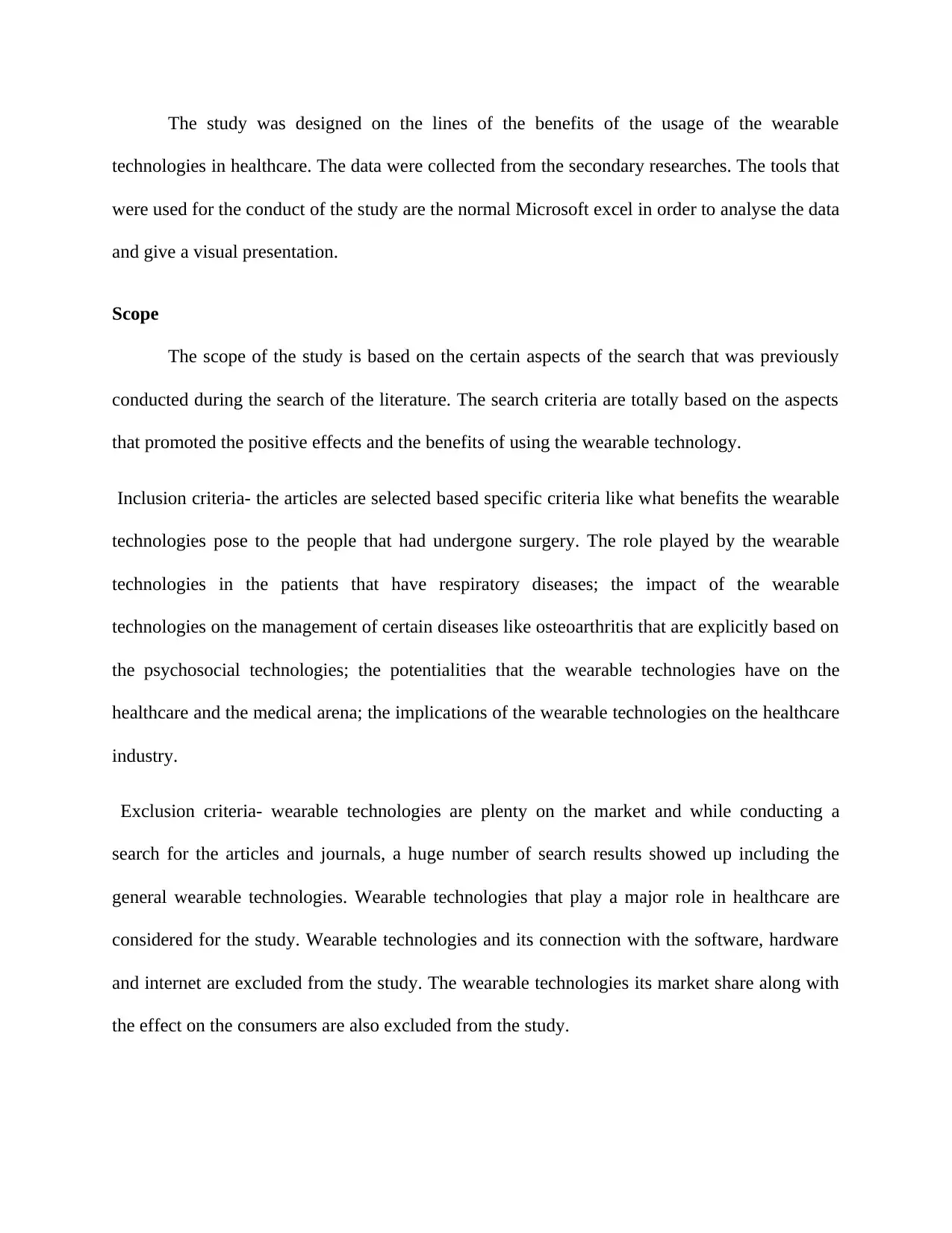
The study was designed on the lines of the benefits of the usage of the wearable
technologies in healthcare. The data were collected from the secondary researches. The tools that
were used for the conduct of the study are the normal Microsoft excel in order to analyse the data
and give a visual presentation.
Scope
The scope of the study is based on the certain aspects of the search that was previously
conducted during the search of the literature. The search criteria are totally based on the aspects
that promoted the positive effects and the benefits of using the wearable technology.
Inclusion criteria- the articles are selected based specific criteria like what benefits the wearable
technologies pose to the people that had undergone surgery. The role played by the wearable
technologies in the patients that have respiratory diseases; the impact of the wearable
technologies on the management of certain diseases like osteoarthritis that are explicitly based on
the psychosocial technologies; the potentialities that the wearable technologies have on the
healthcare and the medical arena; the implications of the wearable technologies on the healthcare
industry.
Exclusion criteria- wearable technologies are plenty on the market and while conducting a
search for the articles and journals, a huge number of search results showed up including the
general wearable technologies. Wearable technologies that play a major role in healthcare are
considered for the study. Wearable technologies and its connection with the software, hardware
and internet are excluded from the study. The wearable technologies its market share along with
the effect on the consumers are also excluded from the study.
technologies in healthcare. The data were collected from the secondary researches. The tools that
were used for the conduct of the study are the normal Microsoft excel in order to analyse the data
and give a visual presentation.
Scope
The scope of the study is based on the certain aspects of the search that was previously
conducted during the search of the literature. The search criteria are totally based on the aspects
that promoted the positive effects and the benefits of using the wearable technology.
Inclusion criteria- the articles are selected based specific criteria like what benefits the wearable
technologies pose to the people that had undergone surgery. The role played by the wearable
technologies in the patients that have respiratory diseases; the impact of the wearable
technologies on the management of certain diseases like osteoarthritis that are explicitly based on
the psychosocial technologies; the potentialities that the wearable technologies have on the
healthcare and the medical arena; the implications of the wearable technologies on the healthcare
industry.
Exclusion criteria- wearable technologies are plenty on the market and while conducting a
search for the articles and journals, a huge number of search results showed up including the
general wearable technologies. Wearable technologies that play a major role in healthcare are
considered for the study. Wearable technologies and its connection with the software, hardware
and internet are excluded from the study. The wearable technologies its market share along with
the effect on the consumers are also excluded from the study.
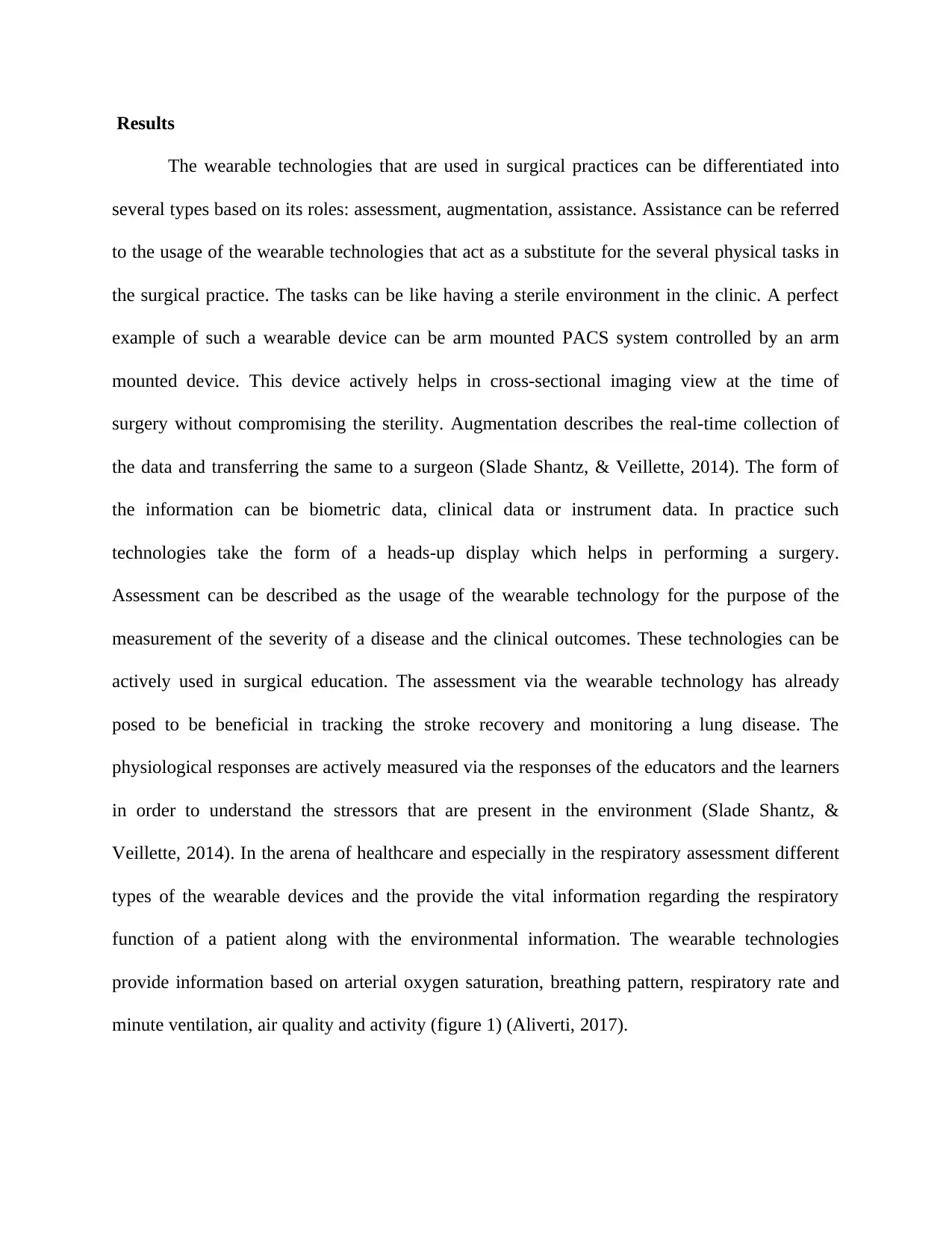
Results
The wearable technologies that are used in surgical practices can be differentiated into
several types based on its roles: assessment, augmentation, assistance. Assistance can be referred
to the usage of the wearable technologies that act as a substitute for the several physical tasks in
the surgical practice. The tasks can be like having a sterile environment in the clinic. A perfect
example of such a wearable device can be arm mounted PACS system controlled by an arm
mounted device. This device actively helps in cross-sectional imaging view at the time of
surgery without compromising the sterility. Augmentation describes the real-time collection of
the data and transferring the same to a surgeon (Slade Shantz, & Veillette, 2014). The form of
the information can be biometric data, clinical data or instrument data. In practice such
technologies take the form of a heads-up display which helps in performing a surgery.
Assessment can be described as the usage of the wearable technology for the purpose of the
measurement of the severity of a disease and the clinical outcomes. These technologies can be
actively used in surgical education. The assessment via the wearable technology has already
posed to be beneficial in tracking the stroke recovery and monitoring a lung disease. The
physiological responses are actively measured via the responses of the educators and the learners
in order to understand the stressors that are present in the environment (Slade Shantz, &
Veillette, 2014). In the arena of healthcare and especially in the respiratory assessment different
types of the wearable devices and the provide the vital information regarding the respiratory
function of a patient along with the environmental information. The wearable technologies
provide information based on arterial oxygen saturation, breathing pattern, respiratory rate and
minute ventilation, air quality and activity (figure 1) (Aliverti, 2017).
The wearable technologies that are used in surgical practices can be differentiated into
several types based on its roles: assessment, augmentation, assistance. Assistance can be referred
to the usage of the wearable technologies that act as a substitute for the several physical tasks in
the surgical practice. The tasks can be like having a sterile environment in the clinic. A perfect
example of such a wearable device can be arm mounted PACS system controlled by an arm
mounted device. This device actively helps in cross-sectional imaging view at the time of
surgery without compromising the sterility. Augmentation describes the real-time collection of
the data and transferring the same to a surgeon (Slade Shantz, & Veillette, 2014). The form of
the information can be biometric data, clinical data or instrument data. In practice such
technologies take the form of a heads-up display which helps in performing a surgery.
Assessment can be described as the usage of the wearable technology for the purpose of the
measurement of the severity of a disease and the clinical outcomes. These technologies can be
actively used in surgical education. The assessment via the wearable technology has already
posed to be beneficial in tracking the stroke recovery and monitoring a lung disease. The
physiological responses are actively measured via the responses of the educators and the learners
in order to understand the stressors that are present in the environment (Slade Shantz, &
Veillette, 2014). In the arena of healthcare and especially in the respiratory assessment different
types of the wearable devices and the provide the vital information regarding the respiratory
function of a patient along with the environmental information. The wearable technologies
provide information based on arterial oxygen saturation, breathing pattern, respiratory rate and
minute ventilation, air quality and activity (figure 1) (Aliverti, 2017).
⊘ This is a preview!⊘
Do you want full access?
Subscribe today to unlock all pages.

Trusted by 1+ million students worldwide
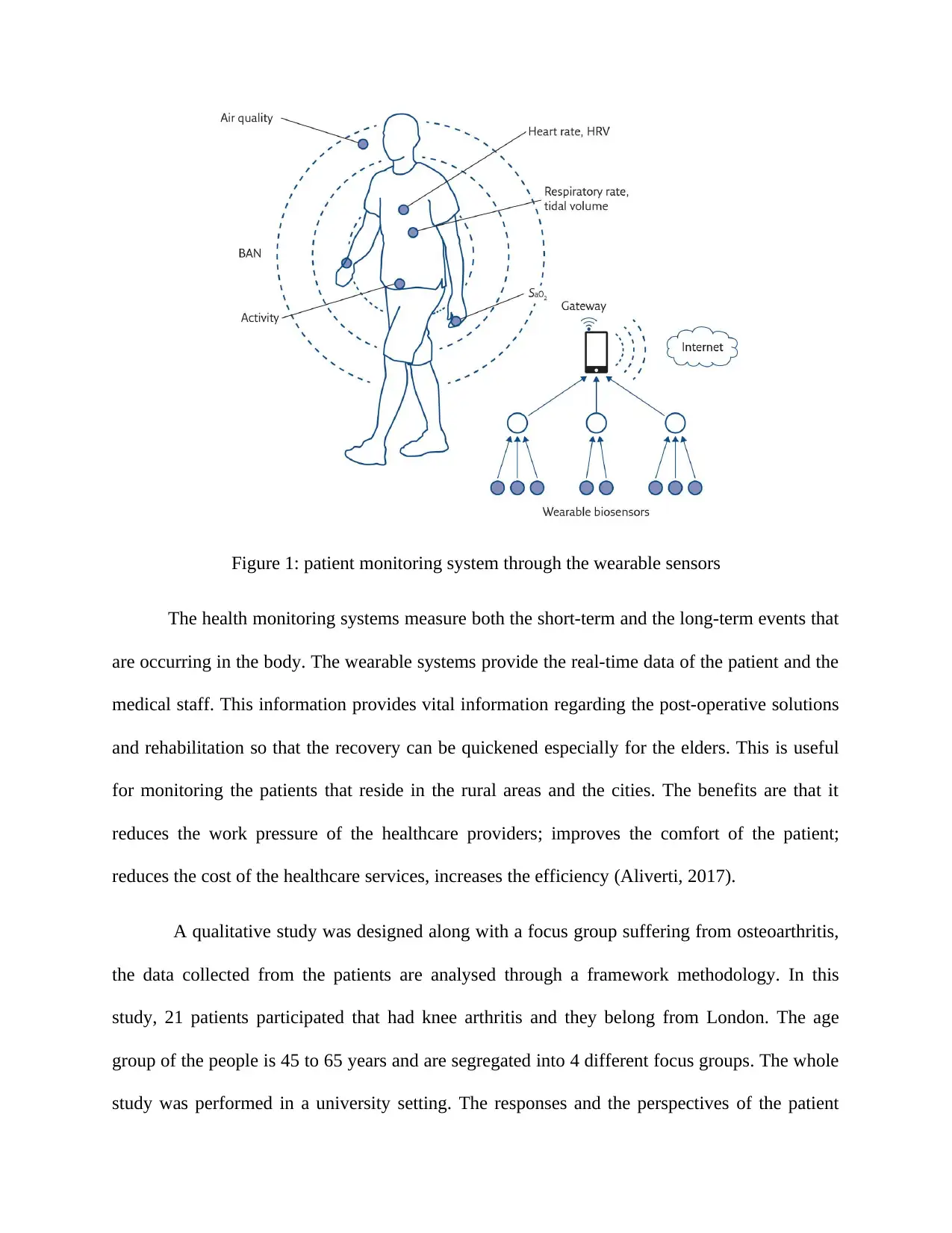
Figure 1: patient monitoring system through the wearable sensors
The health monitoring systems measure both the short-term and the long-term events that
are occurring in the body. The wearable systems provide the real-time data of the patient and the
medical staff. This information provides vital information regarding the post-operative solutions
and rehabilitation so that the recovery can be quickened especially for the elders. This is useful
for monitoring the patients that reside in the rural areas and the cities. The benefits are that it
reduces the work pressure of the healthcare providers; improves the comfort of the patient;
reduces the cost of the healthcare services, increases the efficiency (Aliverti, 2017).
A qualitative study was designed along with a focus group suffering from osteoarthritis,
the data collected from the patients are analysed through a framework methodology. In this
study, 21 patients participated that had knee arthritis and they belong from London. The age
group of the people is 45 to 65 years and are segregated into 4 different focus groups. The whole
study was performed in a university setting. The responses and the perspectives of the patient
The health monitoring systems measure both the short-term and the long-term events that
are occurring in the body. The wearable systems provide the real-time data of the patient and the
medical staff. This information provides vital information regarding the post-operative solutions
and rehabilitation so that the recovery can be quickened especially for the elders. This is useful
for monitoring the patients that reside in the rural areas and the cities. The benefits are that it
reduces the work pressure of the healthcare providers; improves the comfort of the patient;
reduces the cost of the healthcare services, increases the efficiency (Aliverti, 2017).
A qualitative study was designed along with a focus group suffering from osteoarthritis,
the data collected from the patients are analysed through a framework methodology. In this
study, 21 patients participated that had knee arthritis and they belong from London. The age
group of the people is 45 to 65 years and are segregated into 4 different focus groups. The whole
study was performed in a university setting. The responses and the perspectives of the patient
Paraphrase This Document
Need a fresh take? Get an instant paraphrase of this document with our AI Paraphraser
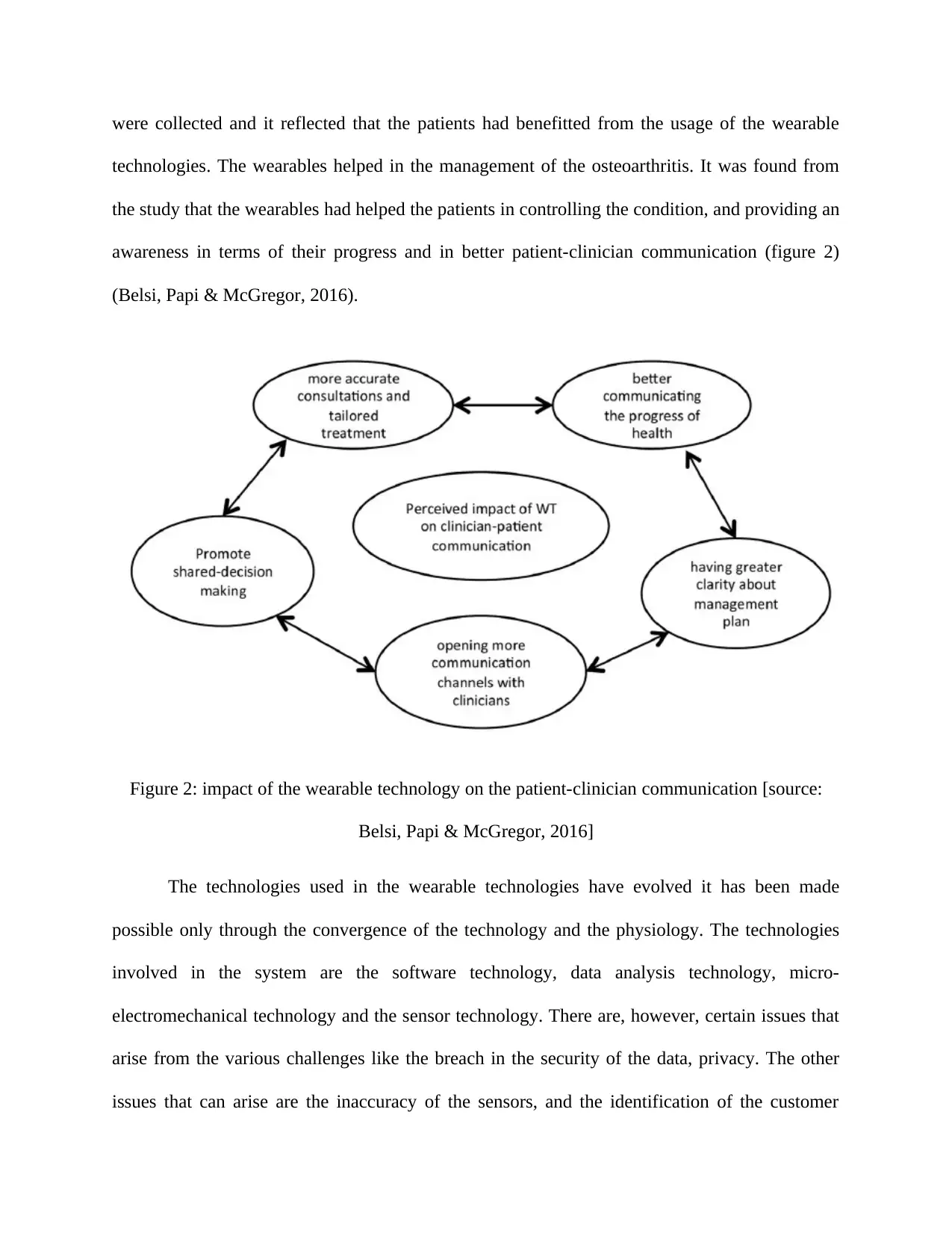
were collected and it reflected that the patients had benefitted from the usage of the wearable
technologies. The wearables helped in the management of the osteoarthritis. It was found from
the study that the wearables had helped the patients in controlling the condition, and providing an
awareness in terms of their progress and in better patient-clinician communication (figure 2)
(Belsi, Papi & McGregor, 2016).
Figure 2: impact of the wearable technology on the patient-clinician communication [source:
Belsi, Papi & McGregor, 2016]
The technologies used in the wearable technologies have evolved it has been made
possible only through the convergence of the technology and the physiology. The technologies
involved in the system are the software technology, data analysis technology, micro-
electromechanical technology and the sensor technology. There are, however, certain issues that
arise from the various challenges like the breach in the security of the data, privacy. The other
issues that can arise are the inaccuracy of the sensors, and the identification of the customer
technologies. The wearables helped in the management of the osteoarthritis. It was found from
the study that the wearables had helped the patients in controlling the condition, and providing an
awareness in terms of their progress and in better patient-clinician communication (figure 2)
(Belsi, Papi & McGregor, 2016).
Figure 2: impact of the wearable technology on the patient-clinician communication [source:
Belsi, Papi & McGregor, 2016]
The technologies used in the wearable technologies have evolved it has been made
possible only through the convergence of the technology and the physiology. The technologies
involved in the system are the software technology, data analysis technology, micro-
electromechanical technology and the sensor technology. There are, however, certain issues that
arise from the various challenges like the breach in the security of the data, privacy. The other
issues that can arise are the inaccuracy of the sensors, and the identification of the customer
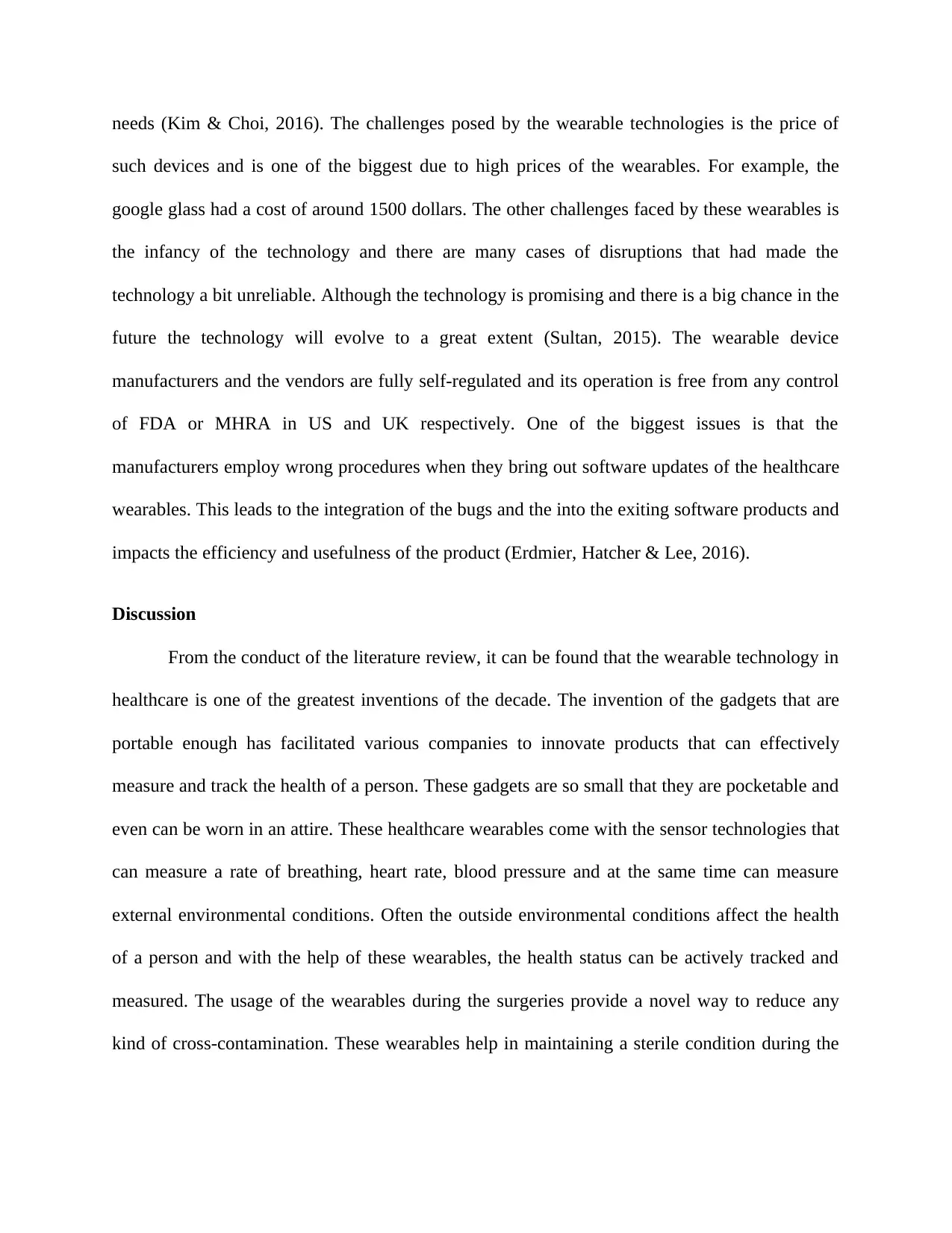
needs (Kim & Choi, 2016). The challenges posed by the wearable technologies is the price of
such devices and is one of the biggest due to high prices of the wearables. For example, the
google glass had a cost of around 1500 dollars. The other challenges faced by these wearables is
the infancy of the technology and there are many cases of disruptions that had made the
technology a bit unreliable. Although the technology is promising and there is a big chance in the
future the technology will evolve to a great extent (Sultan, 2015). The wearable device
manufacturers and the vendors are fully self-regulated and its operation is free from any control
of FDA or MHRA in US and UK respectively. One of the biggest issues is that the
manufacturers employ wrong procedures when they bring out software updates of the healthcare
wearables. This leads to the integration of the bugs and the into the exiting software products and
impacts the efficiency and usefulness of the product (Erdmier, Hatcher & Lee, 2016).
Discussion
From the conduct of the literature review, it can be found that the wearable technology in
healthcare is one of the greatest inventions of the decade. The invention of the gadgets that are
portable enough has facilitated various companies to innovate products that can effectively
measure and track the health of a person. These gadgets are so small that they are pocketable and
even can be worn in an attire. These healthcare wearables come with the sensor technologies that
can measure a rate of breathing, heart rate, blood pressure and at the same time can measure
external environmental conditions. Often the outside environmental conditions affect the health
of a person and with the help of these wearables, the health status can be actively tracked and
measured. The usage of the wearables during the surgeries provide a novel way to reduce any
kind of cross-contamination. These wearables help in maintaining a sterile condition during the
such devices and is one of the biggest due to high prices of the wearables. For example, the
google glass had a cost of around 1500 dollars. The other challenges faced by these wearables is
the infancy of the technology and there are many cases of disruptions that had made the
technology a bit unreliable. Although the technology is promising and there is a big chance in the
future the technology will evolve to a great extent (Sultan, 2015). The wearable device
manufacturers and the vendors are fully self-regulated and its operation is free from any control
of FDA or MHRA in US and UK respectively. One of the biggest issues is that the
manufacturers employ wrong procedures when they bring out software updates of the healthcare
wearables. This leads to the integration of the bugs and the into the exiting software products and
impacts the efficiency and usefulness of the product (Erdmier, Hatcher & Lee, 2016).
Discussion
From the conduct of the literature review, it can be found that the wearable technology in
healthcare is one of the greatest inventions of the decade. The invention of the gadgets that are
portable enough has facilitated various companies to innovate products that can effectively
measure and track the health of a person. These gadgets are so small that they are pocketable and
even can be worn in an attire. These healthcare wearables come with the sensor technologies that
can measure a rate of breathing, heart rate, blood pressure and at the same time can measure
external environmental conditions. Often the outside environmental conditions affect the health
of a person and with the help of these wearables, the health status can be actively tracked and
measured. The usage of the wearables during the surgeries provide a novel way to reduce any
kind of cross-contamination. These wearables help in maintaining a sterile condition during the
⊘ This is a preview!⊘
Do you want full access?
Subscribe today to unlock all pages.

Trusted by 1+ million students worldwide
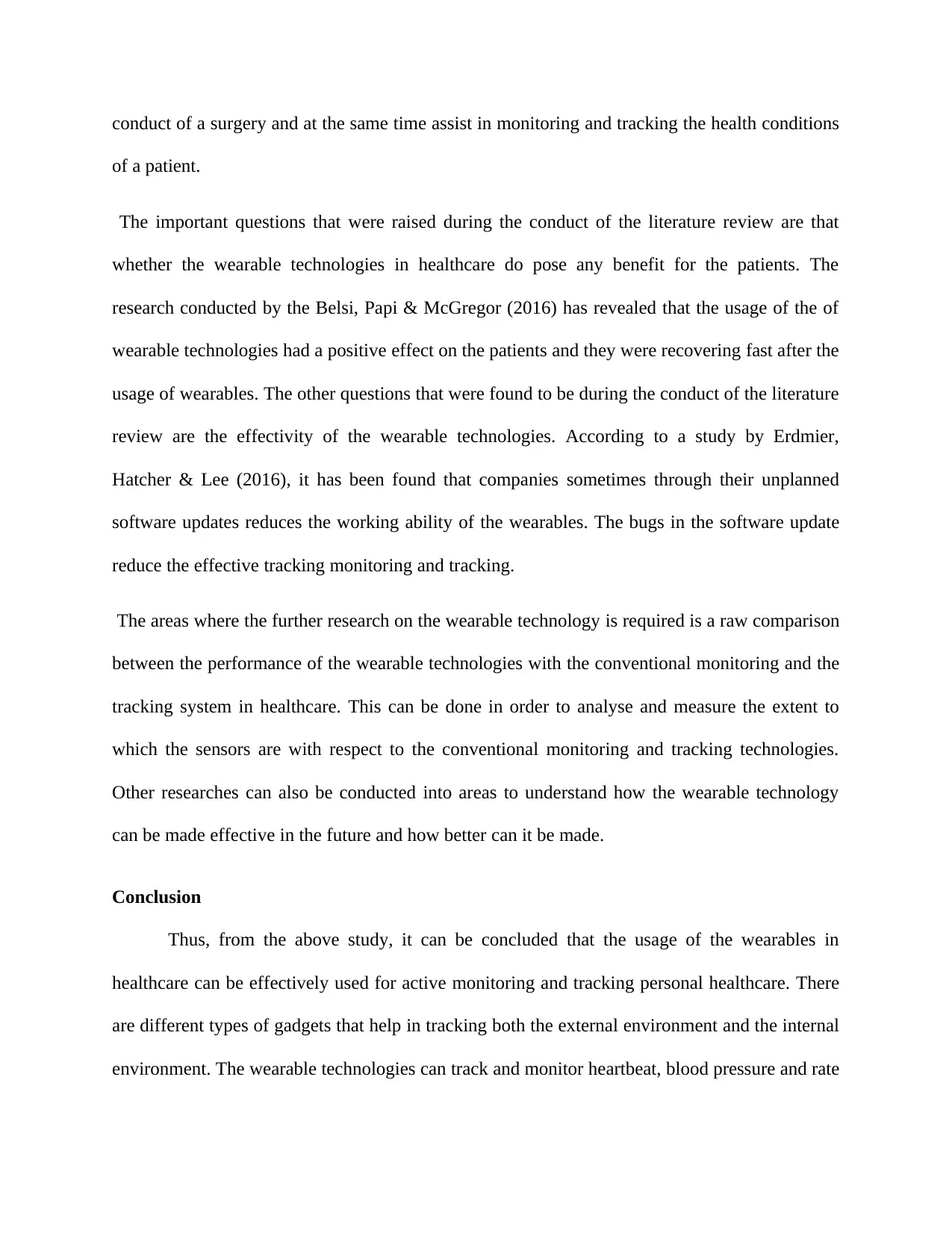
conduct of a surgery and at the same time assist in monitoring and tracking the health conditions
of a patient.
The important questions that were raised during the conduct of the literature review are that
whether the wearable technologies in healthcare do pose any benefit for the patients. The
research conducted by the Belsi, Papi & McGregor (2016) has revealed that the usage of the of
wearable technologies had a positive effect on the patients and they were recovering fast after the
usage of wearables. The other questions that were found to be during the conduct of the literature
review are the effectivity of the wearable technologies. According to a study by Erdmier,
Hatcher & Lee (2016), it has been found that companies sometimes through their unplanned
software updates reduces the working ability of the wearables. The bugs in the software update
reduce the effective tracking monitoring and tracking.
The areas where the further research on the wearable technology is required is a raw comparison
between the performance of the wearable technologies with the conventional monitoring and the
tracking system in healthcare. This can be done in order to analyse and measure the extent to
which the sensors are with respect to the conventional monitoring and tracking technologies.
Other researches can also be conducted into areas to understand how the wearable technology
can be made effective in the future and how better can it be made.
Conclusion
Thus, from the above study, it can be concluded that the usage of the wearables in
healthcare can be effectively used for active monitoring and tracking personal healthcare. There
are different types of gadgets that help in tracking both the external environment and the internal
environment. The wearable technologies can track and monitor heartbeat, blood pressure and rate
of a patient.
The important questions that were raised during the conduct of the literature review are that
whether the wearable technologies in healthcare do pose any benefit for the patients. The
research conducted by the Belsi, Papi & McGregor (2016) has revealed that the usage of the of
wearable technologies had a positive effect on the patients and they were recovering fast after the
usage of wearables. The other questions that were found to be during the conduct of the literature
review are the effectivity of the wearable technologies. According to a study by Erdmier,
Hatcher & Lee (2016), it has been found that companies sometimes through their unplanned
software updates reduces the working ability of the wearables. The bugs in the software update
reduce the effective tracking monitoring and tracking.
The areas where the further research on the wearable technology is required is a raw comparison
between the performance of the wearable technologies with the conventional monitoring and the
tracking system in healthcare. This can be done in order to analyse and measure the extent to
which the sensors are with respect to the conventional monitoring and tracking technologies.
Other researches can also be conducted into areas to understand how the wearable technology
can be made effective in the future and how better can it be made.
Conclusion
Thus, from the above study, it can be concluded that the usage of the wearables in
healthcare can be effectively used for active monitoring and tracking personal healthcare. There
are different types of gadgets that help in tracking both the external environment and the internal
environment. The wearable technologies can track and monitor heartbeat, blood pressure and rate
Paraphrase This Document
Need a fresh take? Get an instant paraphrase of this document with our AI Paraphraser
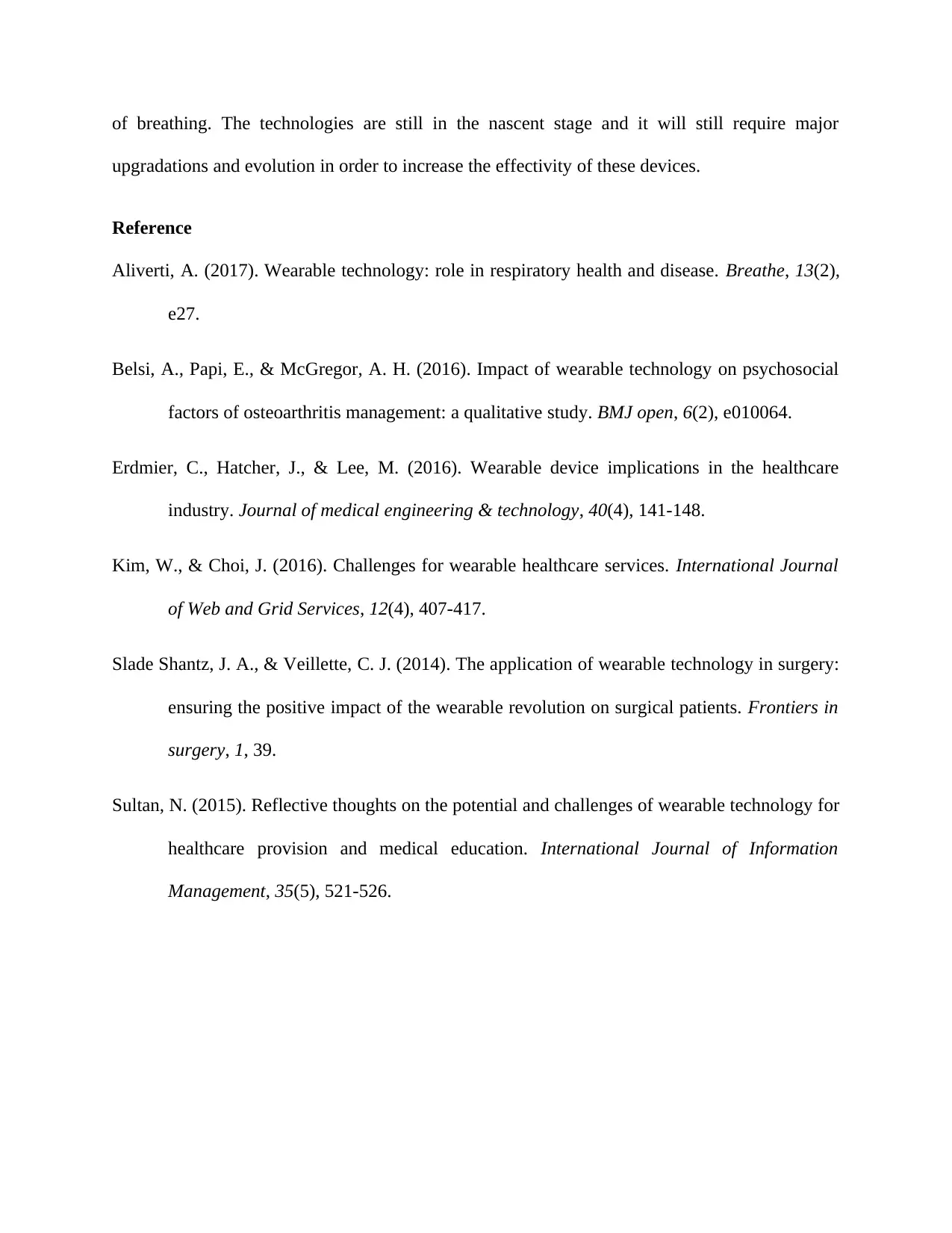
of breathing. The technologies are still in the nascent stage and it will still require major
upgradations and evolution in order to increase the effectivity of these devices.
Reference
Aliverti, A. (2017). Wearable technology: role in respiratory health and disease. Breathe, 13(2),
e27.
Belsi, A., Papi, E., & McGregor, A. H. (2016). Impact of wearable technology on psychosocial
factors of osteoarthritis management: a qualitative study. BMJ open, 6(2), e010064.
Erdmier, C., Hatcher, J., & Lee, M. (2016). Wearable device implications in the healthcare
industry. Journal of medical engineering & technology, 40(4), 141-148.
Kim, W., & Choi, J. (2016). Challenges for wearable healthcare services. International Journal
of Web and Grid Services, 12(4), 407-417.
Slade Shantz, J. A., & Veillette, C. J. (2014). The application of wearable technology in surgery:
ensuring the positive impact of the wearable revolution on surgical patients. Frontiers in
surgery, 1, 39.
Sultan, N. (2015). Reflective thoughts on the potential and challenges of wearable technology for
healthcare provision and medical education. International Journal of Information
Management, 35(5), 521-526.
upgradations and evolution in order to increase the effectivity of these devices.
Reference
Aliverti, A. (2017). Wearable technology: role in respiratory health and disease. Breathe, 13(2),
e27.
Belsi, A., Papi, E., & McGregor, A. H. (2016). Impact of wearable technology on psychosocial
factors of osteoarthritis management: a qualitative study. BMJ open, 6(2), e010064.
Erdmier, C., Hatcher, J., & Lee, M. (2016). Wearable device implications in the healthcare
industry. Journal of medical engineering & technology, 40(4), 141-148.
Kim, W., & Choi, J. (2016). Challenges for wearable healthcare services. International Journal
of Web and Grid Services, 12(4), 407-417.
Slade Shantz, J. A., & Veillette, C. J. (2014). The application of wearable technology in surgery:
ensuring the positive impact of the wearable revolution on surgical patients. Frontiers in
surgery, 1, 39.
Sultan, N. (2015). Reflective thoughts on the potential and challenges of wearable technology for
healthcare provision and medical education. International Journal of Information
Management, 35(5), 521-526.
1 out of 11
Related Documents
Your All-in-One AI-Powered Toolkit for Academic Success.
+13062052269
info@desklib.com
Available 24*7 on WhatsApp / Email
![[object Object]](/_next/static/media/star-bottom.7253800d.svg)
Unlock your academic potential
Copyright © 2020–2025 A2Z Services. All Rights Reserved. Developed and managed by ZUCOL.





